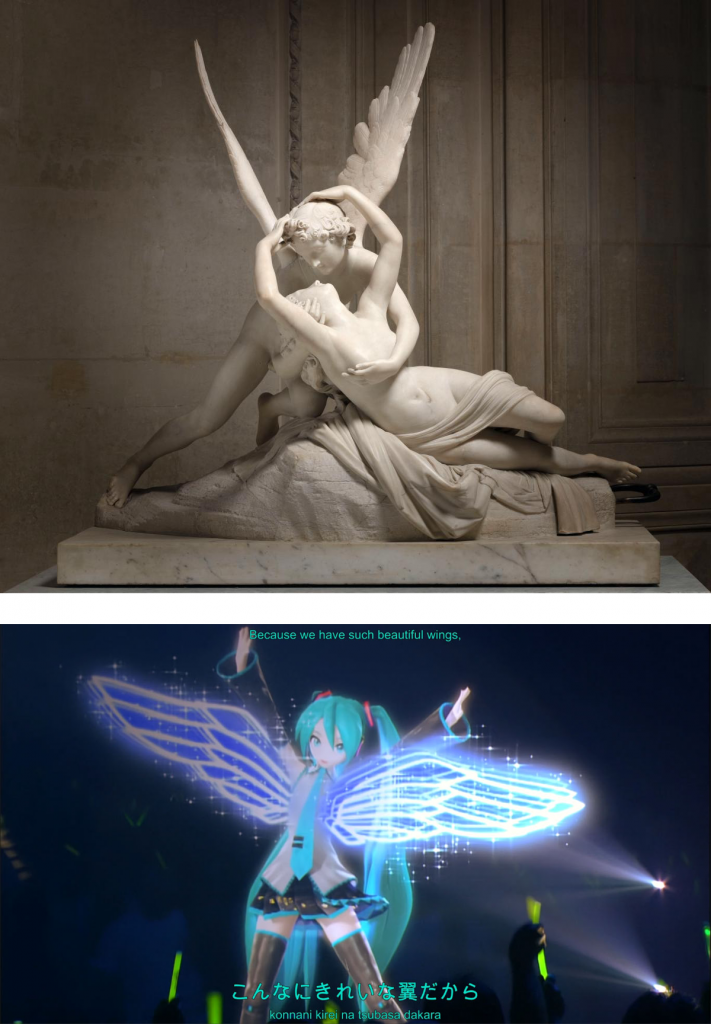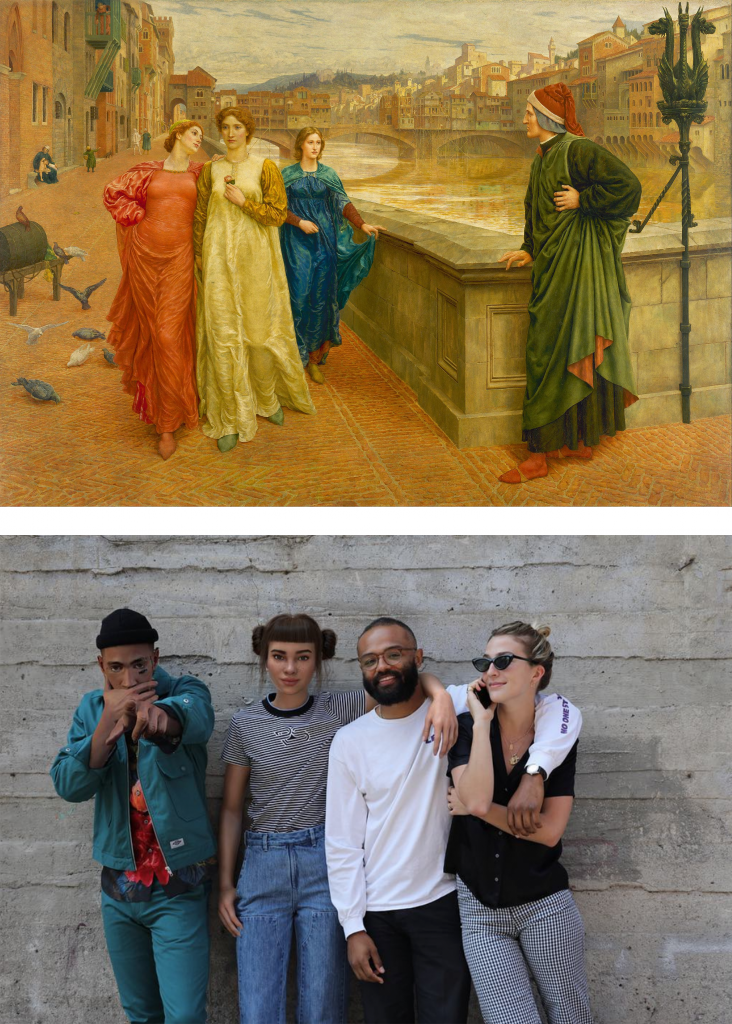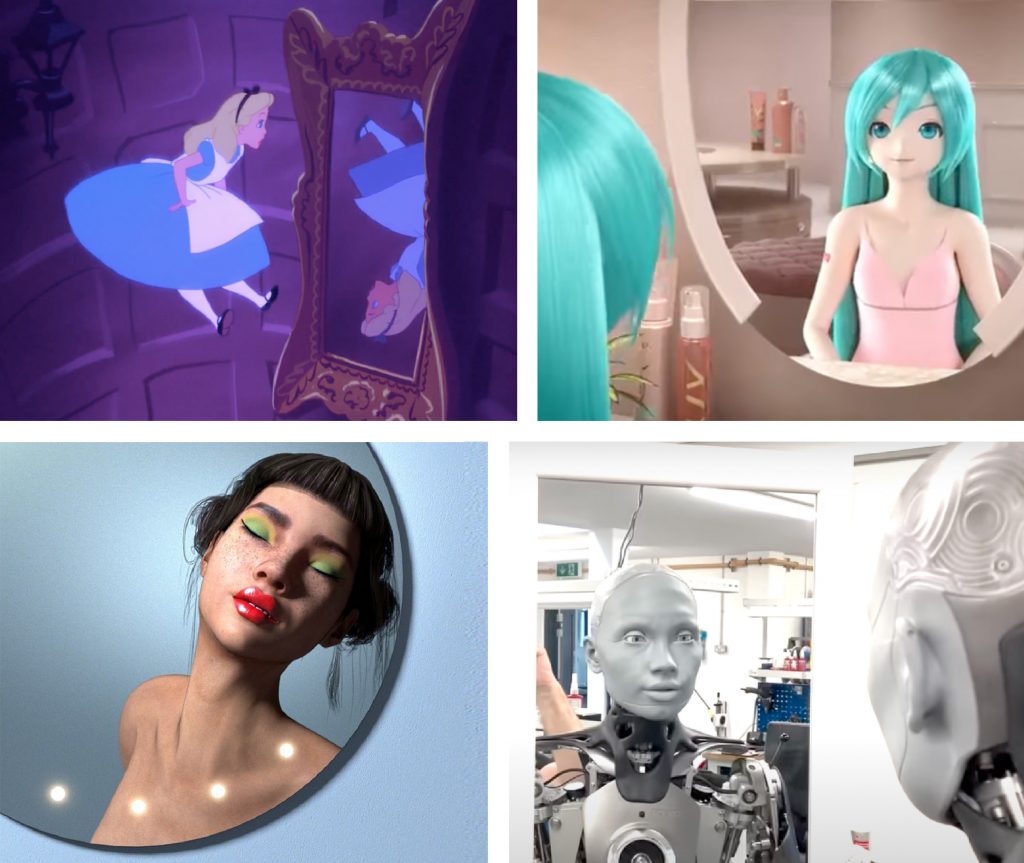This text was originally published in Italian on "Fake. Il falso del XXI secolo", Iconografie.
Edited by Tripta Chandola, Powered by Clusterduck.
It is August 2017. Zaki Miguel is 12 years old. Zaki’s family has been living in Silver Spring, Maryland, since his grandparents, a smiling elderly couple, moved here. They arrived here leaving Lezo, a municipality of about 15,000 located in the province of Aklan, in the Philippines. Zaki opened his Facebook at the age of 5, a curious reader could still find some ‘photos of Zaki’ in many adorable selfies. In these portraits, he is with his father, in the car, on a motorcycle, or playing in the snow. In the first pictures, he’s still living in Kalibo in the Philippines. We may never know, but perhaps he moved to Maryland with his father at the age of 8, and soon after his grandparents reached them.
Anyway, it’s summer. Zaki is 12 years old and owns a smartphone. Maybe he’s sprawled on the couch, living room shades are down, he’s scrolling through Instagram. A picture emerges on his feed, depicting a girl looking at herself in the mirror. The girl’s name is Miquela. Zaki scans her in the dark. Something seems amiss, but he can’t quite put his finger on it. He finally comments with a weirdly mature question: ‘Did you get some surgery to look like that?’1 Comment found under @lilmiquela Instagram post ‘I am amazing, I am a masterpiece’, August 2017, https://www.instagram.com/p/BXqvEegFSCq/, written by Zaki Miguel @itmezak.
It is February 2021. Daniel R. Larson’s business is in shambles due to Covid-19, but he recently took a big step. He launched an online lecture course where you can get a real estate license online in no time 😆💸🤑. He firmly believes that the most important thing in life is to be passionate about something, whatever this may be. To promote his online course, he uses TikTok. Daniel is in his car, wearing a white shirt and tie, he’s recording a video to appear active and brilliant in front of his 153 followers. While stopping at a red light, he scrolls through his feed. A beautiful video catches his eye—it’s Tom Cruise playing golf. He watches it looping a few times and simply experiences joy. Tom Cruise’s confident gestures inspire him. Tom Cruise has finally joined TikTok. Some losers are downing him in the comments. He feels compelled to answer back: ‘This is DEFINITELY the real Tom Cruise.’2Comment found under @Deeptomcruise TikTok post ‘Sports!’, February 2021, https://www.tiktok.com/@deeptomcruise/video/6932166297996233989, written by Daniel R. Larson @gorealestatelicense.
It is October 2022. A TikTok user who goes by the name Bee Commander is sitting on the white carpet of her house. Despite her username being ‘Bee Commander,’ chosen for its association with commanding bees and the internet hive mind theme, she has a genuine love for whales and all gray or green animals, like dinosaurs, turtles, rhinos, and toads. No matter what as long as they are a little rough. She loves losing her thoughts in the distant, cave-like sounds produced by these beasts. TikTok’s algorithm has picked up on her preferences and is quite specific about it. Ever since discovering TikTok, Bee Commander spends almost every afternoon after school rubbing her fingers along the carpet, zapping from an iguana to an elephant. Occasionally, she comes across videos featuring sloths, but she usually skips them. Today, she stumbled upon a video with a hell lot of views. A boy is introducing his ‘giant dumpy frog’ named Dumpy. Bee Commander is puzzled; the frog is so large, she can’t identify its species. She is kinda pissed by the situation. Then she got it: that’s not a frog! She never leaves comments, but she has to rectify this silly inaccuracy: ‘That’s a toad.’3Comment found under @whatslucasup2 TikTok post ‘This is my giant dumpy frog’, October 2022, https://www.tiktok.com/@whatslucasup2/video/7150767451318422830, written by Bee commander @liayen442.
But who are these angry commenters, and what do they have in common? Internet experts already figured it out: they’re users who couldn’t discern the ‘fakes’ who stand before them. These commenters are not just curious, confused or creepy, they are people that did not understand what they are seeing and get angry because of that.
Zaki Miguel’s comment appears under one of the first photos of @lilmiquela, one of the firsts 3D influencers, made in CGI.
Daniel R. Larson stood up for @deeptomcruise, an account on which digital artist Christopher Ume impersonates Tom Cruise using deepfake technology.
Bee Commander is one of the hundreds of users who watched at @whatslucasup2’s video and didn’t realize that his ‘giant dumpy frog’ was simply a small dumpy frog trimmed and magnified on Premiere Pro.
I find myself stalking these random individuals. I watch Zaki’s Instagram stories, where he’s asking people to vote for him as prom king while wearing already an awkward king costume with scepter; I attend Daniel’s useless lectures, or watch, over and again, the one and only TikTok video of Bee Commander, portraying her rubber whale screaming into the void—so beautiful.
It is so beautiful, it makes me wondering:
‘How can this happen? That moment when technology overtakes you, because you don’t understand what’s going on, or you’re distracted, or angry, or paying attention to something else. You go through life thinking you know the drill, and then *poof*, there comes the moment when you find yourself on the other side. The moment when you see and simply believe what’s fake’.
For every technological leap, someone falls. My grandmother, F., is the type of person who will trust someone on the phone, claiming to be from Enel—the main Italian energy company. As for my friend G., illustrator, just a few days ago, she thought it was OK to transfer 1,000 euros to a never-before-seen crypto platform after some days of intimate chat conversations with a Nigerian Instagram influencer who understood her traumacore issues.
In this story, we will transition from one technology to another, attempting, for once, to take into account the perspective of those who may be left behind. Because one day, we might all end up to be those furious commenters, dazed victims, or weirded out boomers. To prevent excessive novelty from overwhelming us, I will rely on skeuomorphic metaphors—things reminiscent of the problematic phenomenon but older and more familiar. I'm also gonna curse a little, but just so as to be clear that it’s not ChatGPT talking. Along the journey, we will encounter fake personas, artificial identities, player and non-player characters. We will collect ❂ anti-fake shield shells and ☀ super fake seal flasks, all in the attempt to understand what happens when everything in our surroundings may just be unreal.

A skeuomorphic metaphor: The mechanical Turk, a fraudulent chess-playing machine constructed in 1770, which appeared to be able to play a strong game of chess against a human opponent (illustration by Joseph Racknitz - Humboldt University Library) *spoiler* a human was hiding inside the machine vs. Google AlphaGo, the AI computer program that plays the board game Go, developed by the London-based DeepMind Technologies, beating the world master of Go, Lee Se-dol.
THOSE THINGS HAVE EYES
In the Deepfake Mellow Valley, we find ourselves running toward a misty moorland. To our left, a sign warns us, ‘Those things have eyes!’ On the horizon, some looming presence is kinda lowering our mood—they are the tall shadows of the first robotic assistants… We approach them thinking ‘oh no, them again’.
The history of artificial identities is lost in the mists of time, but it accelerates visibly as the first robotic assistants make their appearance. At Bell Labs, Audrey (1952) specialized in automatic digit recognition, while at MIT, ELIZA (1964) with her ability to process natural language. The lineage of ‘electronic secretaries’ continues with contemporary voice assistants like Alexa and Siri, and AI chatbots such as Replika AI or Kuki AI. We may never fully grasp the thoughts that crossed the minds of those scientists in their white lab coats at Bell Labs—as seen in documentaries—or those of Apple’s marketing strategists a few years later, but we can kinda imagine. The notion that a semi-intelligent machine is characterized as female, and therefore harmless, weak, subservient, and approachable, stands as one of big tech’s great deceptions to its customers.
Over time, as these shapeless pieces of software assumed female identities, using nothing more than just a name, marketing realized that synthesizing feminine qualities to appeal to the hearts of both ‘forever alone nerds’, ‘career junky proto-chads’, or even—why not—moms and kids, worked exceedingly well. Before long, it was too late; the ‘criminal offense’ of profound deception was out of the box.
In the family tree of fabricated people designed to persuade real people to do things (aka ‘sock puppets’), Hatsune Miku (2007) represents a large mutational change. Miku is the first in a series of Vocaloids produced by the Japanese company Crypton Future Media.
The Vocaloids are fantastical characters designed to embody the actual product—a voice synthesizer. Within days of her launch, both Miku's voice and image were unexpectedly adopted by memers and YouTubers, reaching an exaggerated level of virality for the time. Riding the wave of fame, Crypton decided to treat her as the star she is: her hologram began performing live, spawning a fandom so vast that, thanks to a majority of votes, she won a contest to engrave her image on a satellite headed for Venus. The ubiquitous, eternal, perfect, tireless figure of Miku was used by Crypton to advertise a myriad of commercial products. From automotive to telephony, food to cosmetics, Miku is still selling hot dogs, cookies, shampoo, smartphones, and pizza to otaku, zoomers, and millennials from Japan and beyond.

Antonio Canova, ‘Amore e Psyche’ (First version 1787–1793) – Hatsune Miku’s Hologram performing live for her fans.
But if everyone participates in the fiction and everyone knows that Miku is not real, where is the offense, where is the crime? The deception is as mild as the marketing was between 2007 and 2015: while we think we are consenting, something else is touching our heartstrings, unbeknownst to us. The reason Miku has been so successful is the same reason why almost every picture on the r/Pareidolia subreddit depicts human or animal faces. Or why as children we loved so much to collect action figures. And then Pokémons, and Digimons. Kafka knew this when he wrote about the Odradek,4 Kafka, Franz. ‘The Cares of a Family Man’, in The Complete Stories. Translated by Willa and Edwin Muir. New York City: Schocken Books, 1995. as did Akihiro Yokoi, Tamagotchi’s father: we are all still animists. Being animist, having animist tendencies, does not mean anything strange or far off. It simply means that we are inclined to reflect our subconscious, personality and desires in the objects or natural places that surround us. In order to understand ourselves. This is at least following a very simplified version of Carl Jung’s reinterpretation5Jung, Carl. The Red Book: Liber Novus, Sonu Shamdasani, Ulrich Hoerni (1st ed.)., Philemon series, New York, 2009. of the animism umbrella concept, in turn somewhat devised by Edward Burnett Tylor to brutally bring together all the ‘primitive’ religions and cults that recognized magical and divine powers in nature and the objects of their universe.
Many Pokémon faithfully imitate Kami and Yōkai, the divine spirits that belong to the Japanese animistic religion: Shintoism. Whiscash resembles Namazu (鯰), a giant catfish that can cause earthquakes; Drowzee is inspired by Baku (獏 or 貘), the dream-devouring tapir; Ninetales is Kitsune (狐), the kami fox that can mind control humans and shapeshift.6Stalberg, Allison. ‘Pokemon Are Not Animals, They Are Kami’, Gamerant, January 28, 2022. The many animistic spirits, mainly deriving from Shintoism, and among us today are none other than all Nintendo characters, manga, anime, and action figures. The consequences of this ‘energy wave’ are much more widespread than it seems. It is no coincidence, for example, that the 4chan imageboard, inspired by the Japanese 2chan, was initially dedicated to an anime fanbase. This was also the birth laboratory of the first memes and reaction characters, such as Pepe the Frog and Wojak, which not only maintain a similar ‘animist’ conformation (objects that come to life while expressing complex meanings to mirror one’s subconscious), but also proved capable of emanating a divine totemic power, giving birth to ‘meme magic’. Another case of collateral shinto animism is that of kawaii style, now so widespread that we find ourselves drawing little smiles everywhere, on all our things, our mugs, our sockets, our shoes.

A Namazu being battled by humans (Ishimoto collection kara) – the Pokemon Whiscash (depicted by Naoyo Kimura).
In Miku’s case, as with so many of the ‘products-with-eyes’ that crowd our world, deception dwells within inches from our being human. Like an invisible intruder, the art of marketing insinuates between us and our desire to mirror ourselves in our natural surroundings, replacing a rock, or a waterfall, with a pantheon of gorgeous rubber monsters.
So here we are, picking up the… *bim!* first ❂ anti fake shield shells: what we feel something for is not necessary real; propitious is not to identify with a smiling shoe.
THOSE THINGS CRY!
A little offended, we dispose of our numerous gadgets with a face, imbued with a new mystical sense toward the surrounding universe that has become colorful and full of fruit. We move on, intrigued by a new sign that enunciates, ‘Those things cry!’
A few years passed before European and American communications agencies realized the potential of Miku and digital sock puppets. Or rather, a few years passed before the emotions and imagery of the Western world drifted on social media and the average user came to a degree of intimacy with digital life that even remotely approached that of nerds and otakus, giving rise to a new market segment, that of the 3D influencers.
The first sock puppet, somewhat randomly and nonsensically named, was Lu do Magalu (2013). She started as a virtual anchorwoman for the YouTube channel of Magazine Luiza, one of Brazil’s largest retail chains. Since her first appearance on the company's Instagram channel, Lu’s face has softened, fans have seen her cry when Brazil lost the World Cup, laugh in her #dancechallenge on TikTok. Along the lines of Miku, Lu is a funny artifice behind whose mask lies the emotional and hegemonic strategy of a corporation. It’s the same old refrain, ‘corporations do not cry,’ but their virtual avatars do. It is 2015, marketing and propaganda are now invading social media. In all the creative briefs, only two words appear, recurring and everlasting: ‘disruptive’ and ‘storytelling,’ and in the war of conquest, especially one in which we confront other or alien cultures, deception is a key weapon.
Nothing is new under the sun. In The History of the Conquest of Mexico (1843) William Prescott recounts how the warring Aztecs used to wear cumbersome and ceremonial robes, adorned with very visible colorful feathers and wooden helmets carved with animal faces.7Prescott, William H. History of the Conquest of Mexico, Modern Library, New York 2001.
They could hardly have gotten the better of Cortez’s Machiavellian strategies, who had his men disguise themselves, donated infected blankets to their opponents and used Malinche’s local knowledge to get into their minds.
Deception as the major tool for combat, appears on epics and ancient strategy manuals across the world. Starting from Iliad, where Ulysses is one of his earliest masters, to General Sun Tzu's The Art of War, where we are told: ‘All warfare is based on deception’.8Tzu, Sun. The Art of War, translated from the Chinese by Lionel Giles, M.A. (1910), Allandale Online Publishing, Leicester 2000. https://sites.ualberta.ca/~enoch/Readings/The_Art_Of_War.pdf.
In The Dark Forest (2008), the second book of Liu Cixin’s Remembrance of Earth’s Past trilogy—soon on our screens—the invading aliens can observe everything with their Sophons but the human thoughts. The highly evolved Trisolarans, due to their telepathic abilities, *spoiler alert*, cannot fully grasp the concepts of ‘deception’ and ‘lie’, and for that very reason they are unable to process any complex strategic thinking.9Cixin, Liu. The Dark Forest (The Three-Body Problem Series, 2), translated by Jel Martinsen, Tor Books, New York, 2015. *Plin* we collect the ☀ first super fake seal flask: misinformation acts (acts of misinformation) are pivotal in shaping our strategic intelligence.

Jesús Helguera, ‘La Malinche’ (© Calendarios Landin) – Lil Miquela during a photoshoot on the Pismo Beach Sand Dunes for Notion Magazine (picture by JUCO).
Miquela Sousa’s story, aka @lilmiquela, a half-Brazilian, half-Spanish 3D influencer, is the story of how the weapon of ‘things that have eyes’ was honed to a scientific level by Californian venture capitalists.
Born on Instagram in 2016, posts on her account are rare and inconsistent until when, during June 2017, something happens. Miquela starts posting almost every day and after two months she changes her look, morphing into a much more elaborate and expensive version of herself.
During that week her first single Not Mine is released, leading Billboard to compare her to Gorillaz and Hatsune Miku.10In what appears to be non signed a paid featuring… ‘Virtual It-Singer Miquela Says ‘Controversy Doesn’t Mean Anything’: Interview’, Billboard Brazil, September 2017. https://www.billboard.com/music/music-news/virtual-instagram-miquela-controversy-interview-7964899/. Today, looking at her feed, it is easy to notice the exact timing at which a team of professionals takes shape behind her fictional persona. Not only 3D artists, but also creatives, copywriters, music producers, marketing strategists and social media managers. But back then no one yet ‘knew’. With her new appearance Miquela created doubt and confusion. Zaki Miguel, whom we found at the beginning of this story, is one of the many minors who believed that Miquela was a real person. For the internet veterans, reactions were different. They would have liked to point out uncanny things, details that can’t add up: ‘WHY DO YOU LOOK LIKE A SIMS CHARACTER?’ / ‘Hummm why her hair is always same? 😔🤔🤔’ / ‘Gurl where did you put your belly button’. Or to let their conspiracy mind get wild: ‘Is this an art project?’ / ‘Who is behind this?’. Just six years have passed and all of them look like such expert wise asses now…
Meanwhile, Miquela engages in social and crowdfunding campaigns, and many brand features. She pays tribute to David Lachapelle and Lil’ Kim, while an image of Miquela tattooed in Louis Vuitton ‘breaks the internet’. But then, out of the blue, on April 18, 2018, Miquela’s account is ‘hacked’ and invaded by posts from another 3D influencer.11Shieber, Jonathan. ‘Update: Virtual Instagram celebrity ‘Lil Miquela’ has had her account hacked’, TechCrunch, April 2018. https://techcrunch.com/2018/04/17/virtual-instagram-celebrity-lil-miquela-has-had-her-account-hacked/?guccounter=1.
Bermuda is Miquela’s nemesis: a Donald Trump supporter, white, blond, and mall-loving, she describes herself as a ‘self-identifying robot’. And as a self-identifying robot, she is proudly and openly talking of Cain Intelligence, the corporation that created her. Bermuda accuses Miquela of deceiving fans into thinking she is a real person. Meanwhile, the culture war that is dividing the social media multitudes (Trumpians vs. liberals, alt-righters vs. social justice warriors) is reenacted in the comments to posts and blogs spreading the Miquela vs. Bermuda drama, as the performance becomes a new reality.

A screen capture of the Cain Intelligence website, taken by the author in 2017. The website no longer exists. - @bermudaisbae being total bff of @lilmiquela later on.
This theater is a pale imitation of a warfare activity that originated around 2011, in Putin’s Russia, and since 2016 has landed in Trump’s America. The novelty is the armies of ‘troll factories’ or ‘troll farms.’ The Russian journalists Dmitry Volchek12Volchek, Dmitry. ‘One Professional Russian Troll Tells All’, Radio Free Europe, March 2015. https://www.rferl.org/a/how-to-guide-russian-trolling-trolls/26919999.html. and Anastasia Denisova13Denisova, Anastasia. Internet Memes and Society. Social, Cultural, and Political Contexts, Routledge, New York, 2019. had been the first to study this phenomenon. In Internet Memes and Society (2015) Denisova recounts how, as the influence that digital platforms have over propaganda becomes significant, the Kremlin decides more and more to strengthen its online presence, applying to social media the ‘Vladislav circus’ strategy, central to maintaining power since the beginning of the Putin government, well described by Adam Curtis in his Hypernormalisation (2016), or to be even more specific, the все неоднозначно (‘everything is ambiguous’) strategy.
A strategy made up of double bottom boxes and coups de théâtre, such as: the creation of fake political parties, media and magazines, for the diffusion of conflicting and inconsistent news. A doctored design of whatever that can raise chaos all over the political landscape and information spaces, consequently excluding people from the games, while those who are in power act hidden and undisturbed.
On social media, old school censorship is impossible to achieve. It will require human resources that only China has to this date. Isn’t it way less expensive to pollute antagonistic constructive conversations with a neverending white noise? These could be made, thanks to a dissimulators factory, which already in 2015 had more than 400 employees, active with very long shifts—the internet never sleeps—and instructed to generate sterile discussions in the political debate, using aggressive comments, hate speech, random praises to the government, nonsensical links, conspiracy theories and gossip. Sounds familiar isn’t it? The whole social internet is now deep into this clusterfuck.
In Miquela’s marketing strategy, the culture war is hijacked to jump on the rage-baiting train and pimp the views: angry people click, comment and share a lot.
After 48 hours Miquela manages to regain possession of her account, and confesses: she is not human, her creators lied to her. She reveals their names: DJ and producer Trevor McFedries and entrepreneur Sara DeCou, founders of a startup named Brud. It later turns out that Bermuda is also a creation of Brud.14Brud on Crunchbase, https://www.crunchbase.com/organization/brud and on PitchBook https://pitchbook.com/profiles/company/180867-79#overview. The most frequent criticisms Miquela had been exposed to—deceiving teenagers and being a stereotype of wokeness while exploiting the image of Latina women—are resolved with a perverse détournement: she did not know. Taking her distance from the ‘media company’ that created her, Miquela achieves a new false autonomy and purity, winning back the hearts of her fans.
The dissimulation layers are quite a few, let’s count them. One: a 3D influencer is pretending to be a real person. Two: the 3D influencer pretends to be hacked by—three—another 3D influencer, claiming to be a robot. Four: this further robot is mimicking a culture war that is in turn—five—a form of ‘reverse censorship’, egged on by government trolls, that prevents users from having constructive forms of online dialogue. Six, the 3D influencer claims to be a victim of Brud’s managerial choices, defending—seven—her own intelligence and ‘agency’ while confusingly appealing to the concept of AI autonomy.
The firm is presented as a start-up founded by a DJ and an entrepreneur, except that, this is really layer eight, Trevor and Sara themselves are—as is often the case with start-ups CEOs with large upstream funding—mere ‘screen to the truth’.15Alighieri, Dante. Vita Nova. Trans. Andrew Frisardi. Evanston: Northwestern UP, 2012. Their personas are there to deflect attention from the various California and New York venture capital funds which support Brud, most notably the Amazon Alexa Fund, Sinai Ventures, Spark Capital and BoxGroup. A congregation interested in creating the first case study of a market that is set to expand dramatically and now threatens to surpass that of human influencers.16Yurieff, Kaya. ‘Instagram star isn't what she seems. But brands are buying in’, CNN BUsiness, April 2018. https://money.cnn.com/2018/06/25/technology/lil-miquela-social-media-influencer-cgi/index.html.

Henry Holiday, ‘Dante and Beatrice’ (1839 - 1927), Dante looks at Beatrice's friend, ‘The screen of truth', so as not to dishonor Beatrice – Miquela and Blako with Brud Co-Founders Trevor and Sara.
And to think that some poor people would have stumbled as early as the first level of storytelling. Let’s pick up *bibim!* the ❂ second anti fake shield shell: in battle and on screens, deceptions conceal themselves like the renowned skins of an onion.
THOSE THINGS ARE SELF-GENERATING!
We exit the labyrinth, leaving behind the giant face of Miquela who cries out in despair, shaking her Louis Vuitton bag. While doing so, we run toward a new sign: ‘Those things are self-generating!’ doesn’t look fucking promising, and in fact, horror. A flat floor of misshapen faces and five-pointed stars unfolds before us. We take courage and start walking on it, one step at a time, trying not to step on their noses, which point up the air as the ugliest flowers ever conceived…
Even without bothering with the still expensive art of 3D modeling, it really seems that for the past couple of years, using deepfake technology, generative AI, photo editing, in combination with some fake social media accounts, anyone could build a small army of fake creatures, with the aim of conquering the internet.
Are we in an unprecedented situation? Not really—fake roule n. 343: ‘If it exists, or can be imagined, it already happened in Japan’.
The record label of AKB48, the J-Pop idols group based in Akihabara, has already tried this in 2011. In the Japanese Playboy17Aimi Eguchi on the cover of Japan PlayBoy 2011 No.26, https://picclick.com/Japan-%E3%80%8EPLAYBOY%E3%80%802011-No26%E3%80%8F-AKB48-Aimi-Eguchi-Shizuka-221815898339.html. a new member of the group, Aimi Eguchi, who after a spasmodic research by the fans turned out to be a Frankenstein, a photomontage made from the best parts of seven human AKB48s...18Rosenfeld, Everett. ‘Japanese Scientists Build a Perfect (and Fake) Pop Star’, Time, June 2011. https://newsfeed.time.com/2011/06/24/japanese-scientists-build-a-perfect-and-fake-pop-star/.
As Lacan would have said: ‘I love you, but, because inexplicably, I love in you something more than you—the objet petit a—I mutilate you’.19Lacan, Jacques. The Seminar of Jacques Lacan: The Four Fundamental Concepts of Psychoanalysis (Book XI), translated by Alan Sheridan, W.W. Norton & Company, New York, 1998.
A marketing experiment that today makes us smile, but also helps us understand more complex and current events.
The stories of Aimi Eguchi and Lil Miquela sustain protective shells which keep upcoming fake personas, shielded from us. As Erica March, the left-wing twitter influencer who since the opening of her account in September 2022 has come to accumulate more than 130 thousand unsuspecting Twitter followers, before her account was suspended after only ten months of life, reported by numerous users as a rage-baiting generated deepfake. The experiment was reminiscent of the misinformation and attention farming strategies of troll farms, not surprisingly very similar to the style of the confusing cloud of alt-righters and characters associated with the 2016 Trumpian campaign, which is why after a few months of scandal and confusion Erica was quickly exposed.20Rissman, Kelly. ‘Twitter suspends ‘rage-baiting’ leftist Erica Marsh account amid claims it’s fake’, Independent, July 2023. https://www.independent.co.uk/news/world/americas/twitter-erica-marsh-account-suspended-b2370888.html.
Miku and Lu’s stories should make us completely unmoved by the statement that NetDragon Websoft, the Chinese company that develops and distributes MMORPGs in China, released on its Weixin channel (the WeChat on Chinese soil) in August 2022:21Rissman, Kelly. ‘Twitter suspends ‘rage-baiting’ leftist Erica Marsh account amid claims it’s fake’, Independent, July 2023. https://www.independent.co.uk/news/world/americas/twitter-erica-marsh-account-suspended-b2370888.html. Tang Yu, the generative AI and first digital human to hold executive positions in the company, has been appointed NetDragon’s rotating CEO.22Yu, Cheng. ‘AI-powered ‘boss’, staff getting along thanks to HK-listed enterprise’, China Daily, December 2022. https://global.chinadaily.com.cn/a/202212/13/WS6397dee7a31057c47eba419f.html. The news, according to which a virtual humanoid robot with artificial intelligence managed to outperform the Hong Kong Hang Seng Index in the six months after his appointment as head of the company, streamlining the flow of processes, helping employees make more rational decisions, and to top it off by meeting with his business partners in the metaverse, went all around the clickbaits, from Gizmochina to The Independent, only to fall on deaf ears.

Aimi Eguchi and the 6 other human AKB48s from which body parts were stolen to create her (2011) – The AI CEO Tang Yu (2022).
Disruptive campaigns have a very short expiration date. On the n.1° list of the “been there, seen that, done that” we should probably add the sensational GenAI IG influencer Aitana Lopez, “Barcelona 💖 Gamer 👾 Fitness 💪🏻 Cosplay Lover 👙” currently flying at 234K followers and a 10K euros monthly revenue.23Leslie Katz. ‘This AI-Generated Influencer Can Pull In Almost $11,000 A Month’, Forbes, 24 November 2023. https://www.forbes.com/sites/lesliekatz/2023/11/24/this-ai-generated-influencer-can-pull-in-10000-euros-a-month/.
Self-generating content speed of a plausible future AI app that can simultaneously interact with ChatGPT, Midjourney, DALL-E, Runaway, Gemini, or with anything else created in the next 10 seconds, to produce shit and post it on its Instagram, Tiktok, or *sigh* X, could indeed give an unprecedented boost to sockpuppet creators; but on the other hand, even we humans are capable of a little deep learning.
So here we are at the ❂ third anti fake shield shell: while their techniques shapeshift as times change, fakers always repeat themselves. So let us see what repeats itself and what evolves itself.
Rage baiting strategies, from Pizzagate (2016) onwards, have found fertile ground in hijacking ancient conspiracies (Area 51, Illuminati, Jet Fuel Can’t Melt Steel Beams), while creating new conspiracy theories (QAnon, Biden is a Robot, Plandemic). These kind of content is nowadays polluting the very concept of counter mainstream media news and counter information, as it was conceived from Indymedia to Wikileaks, as well as the deeper concept of ‘ontological pasture’, emphatically defended by Erik Davis: the benefit of the doubt that the seeker must give to irrational hypotheses in order to discover new and strange things.24Davis, Erik. High Weirdness Drugs, Esoterica, and Visionary Experience in the Seventies, The MIT Press, Cambridge, 2019.
All those experiments in collective creative writing that characterized the internet lore and worldbuilding, from ‘Dolphins are Evil’ to ‘Birds Aren't Real’—subreddits created for the lulz back then—are also somehow entering the post-Qanon infographic posters core, initiated by the Deep State Mapping Project.
Are we at risk losing them both, the user generated content wikis and the creative writing lore? Let’s say it will be harder and harder to preserve that, while Wikipedia itself is currently under attack by many fakers and frontes.
Sockpuppeteering activities meanwhile have jumped from one technology to another, as its nature dictates. Scammers, for example, have found an edge in Eleven Lab, one of many generative AIs that allow, with a meager database of two or three minutes of recorded speech, to imitate anyone’s voice, simulating phone calls coming from kidnapped daughters or from CEOs asking their employees for money. Past the metaverse trend, which now is so Covid lockdown, and fading from the disruptive influence of social media, 3D influencers and generally fake people who become famous apparently will not cease to exist soon, but they mortally bore the not-newbies and or chronically online people. As we are.
Let us then focus on the famous people used in a fake way instead.
Deepfake technology is inextricably linked to celebrities. During 2018 everyone on the internet stumbled somehow upon a video in which, using the software Synthesizing Obama (2017), the beloved former U.S. president talks about the dangers of deepfake technology while, next to him, an actor moves and speaks his exact words in sync, letting us know that Obama is his own puppet. Many people have seen the deepfake edited porn videos of Emma Watson or Kim Kardashian. These could be found directly on the r/deepfake subreddit, homonymous to u/deepfake, the mysterious user who originated the word, winking to neural network deep learning, and describing a situation in which a synthetic media is used to convincingly replace the likeness of one person with that of another.
While redditors were dealing with copyright-infringing porn, those who own celebrities’ image rights, such as heirs, museums and record companies, in order to continue monetizing the monetizable, set about resurrecting the dead. It happened to poor Dalì, Elvis Presley, John Lennon and Kim Kardashian’s father. Compared to the first famous resurrection—that of Tupac’s hologram at Coachella 2012—made by a Hollywood super effects studio through the stitching of various images of Pac when he was alive, these new deepfakes can actually speak to us, give us the illusion that they contain the style, knowledge, and in short, the soul of the famous deceased, to whom the eternal rest has been denied.
Famous people are the most imitated because they are the easiest to imitate. Their face is present in all the internet, therefore by accident, in all databases of the Gen AI software we use today. They have already appeared by default in deepfake apps such as the Chinese Zao or the Canadian Wombo AI, which from 2019 to 2020 allowed us to create meme after meme. It follows that—in addition to the paparazzi—with all the goodness of data they have willingly or unwillingly distributed online, celebrities today will have to be careful not to completely lose control over their synthetic personalities, a Streisand effect on a catastrophic scale.
Celebrities are also the most imitated because using their image is obviously convenient in terms of reach. A living or non living proof of this is the already mentioned @deeptomcruise, who by exploiting the sacral aura of the Top Gun star has now become an influencer in his own right, especially since the real Paris Hilton gave him her blessing. @unreal_keanu followed his steps, reviving another not dead deity, Keanue Reeves. And while the emergence of new Hollywood stars is inhibited by Netflix and the new lineage of ‘social celebrities’ is rising, a new market could be opened, that of the post-Hollywood productions with the deepfake revival of the ancient ‘actor royalty’.
Can you imagine how well the tired faces of De Niro, Al Pacino, Cate Blanchett, DiCaprio, Meryl Streep and, for the love of God, Nicolas Cage please, would fit in a drama edited on Runaway 3 with a PC and two graphics cards in Uganda? Hollywood actors and screen players know it so well that they just came out from a 3 month strike, in the desperate attempt to protect their image and copy/rights.
Satire had so much new material to work with, from the representations of Bolsonaro created by Bruxo dos Vídeos, to the photos and videos of Trump’s arrest as he rolls over himself in an attempt to flee from the police, until the omnipresent and omniscient Papa Balenciaga. While ChatGPT is drinking 500ml of water every 50 to 500 prompt, more and more artists are using Midjourney or DALL-E to depict the horrid state of climate catastrophe in which we find ourselves—yes, we are as much twisted and fucked up! But, well done, if the deepfake served to the Belgian branch of Extinction Rebellion, spoken by the mouth and face of fake Prime Minister Sophie Wilmès, to inform more than 100,000 people of real facts, namely that the most recent global epidemics, such as SARS, Ebola, swine flu and now Covid-19, are the direct result of ‘human exploitation and destruction of our natural environment’. Speaking through the aura of celebrities is not all that bad.
In the meantime, there are those who get mad while working on deepfake recognition softwares, trying to defend the already devastated integrity of news, with hypotheses of smart contracts on blockchain to certify sources, or alternatively recognition apps that, however, have so far proved more useful to those who train deepfake intelligences, than to debunkers.
Is the time coming when AI will overtake us? The terrifying time, when we too will end up as Daniel R. Larson or the other dazed and confused users? Confusion is for certain the key ingredient of Biden’s America. This past August, Potus lovely invited Amazon, Anthropic, Google, Inflection, Meta, Microsoft, and OpenAI to eat some cake at the White House, kindly encouraging them to endorse responsible practices in the development and use of those weird AI things they are working on. Who knows if during the tea, anyone tattled on the various members of the ethics teams who were fired on the spot, as it happens sometime with uninvited distant aunts: Margaret Mitchell and Timnit Gebru, co-leaders of Google's ‘ethical AI’ team, all the members of Microsoft ‘ethics and society’ team, just to say a few.
The EU parliament, Council and Commission have taken approximately 3 years to agree on the EU AI Act, which is now passing to the election and agreement stage. At this pace, the members of the European Parliament themselves are risking to be supplanted by the whatever-tenth multimodal AioT version of ChatGPT, even before the act goes into effect. Meanwhile, we perpetually online humans are bound to experience the most diverse stages of excitement, rejection and adaptation.
These considerations make us realize that rather than the danger of deepfake technology, we should maybe focus on how we can preserve the right to dialogue and passage of knowledge.
Here we are then at the *blup* ❂ fourth anti fake shield shells: any mediated exchange can be highly divisive. As in Gregorio Magini’s short story, Il sacrario degli specchi infranti (2023),25Gregorio Magini. ‘Il sacrario degli specchi infranti’ in L’anno del fuoco segreto, curated by Edoardo Rialti and Dario Valentini, Bompiani, Firenze, Milano, 2023. the world is in danger of ending as everyone believing it is ending in a different way, contributes to its destruction in their own particular way. Disinformation mutates at the speed of light and ChatGPT makes clickbait automation possible, generating monsters such as Celebritiesdeaths.com—the site that automatically generates news about the death of living or dead celebrities—or ScoopEarth.com—a collection of completely fake and also automatically generated scoops about real and living celebrities.

Pentagon UFO videos "GIMBAL" video, Jan 2015, released on 2023, sourced from MQ9 military drone vs. a UFO video generated on the WOMBOT.fun AI app – One of the Mexico's controversial 1,000-year-old 'alien' bodies vs. Mexico's ‘Alien Corpse’ being cut like a cake, created by Ben Cullen, a tattoo artist and baker from Birmingham.
In this hodgepodge of rumors we see shining, at the bottom of the cavern we have absent-mindedly entered, the *vshhh* ☀ second super fake seal flasks: legitimate is committing ‘crime of deepfake’. It may seem absurd but, in a scenario where horizontal communication among multitudes is limited by social platforms design and disturbed by the white noise of misinformation, the aura of famous people has become a small lantern under which to gather, a node for episodic exchanges, conveyed by memes and their ability to jump from one community to another.
THOSE THINGS THINK WEIRD!
Exhilarated by this newly conquered feature, but also a little shocked by the angular mountains of all different iridescent colors covering the now near to sunset sun, we turn our lantern to the road ahead. Another warning in this lonely moment heartens us: ‘Those things think weird!’ And moving forward through a corridor of mirrors we realize that the creatures that inhabit are itself a shining light. All well and good, except that as we try to go through them, their appearance varies, taking the shape of our hands, our feet, our eyes...
As we have seen, users have shown that they hate 3D influencers and deepfakes who are too human. An almost physical rejection, alternating between anger at being deceived and the fear that one day they are to be replaced by something equal but better. Uncanny things happen when we mirror ourselves in something else and recognize a sibling, but not everything fits. Our animistic drive as sociable little humans meets a convex mirror, a mismatch. In antiquity we would have experienced this in front of a statue. Speaking of statues, there are still some that can bring us similar feelings, or that were carved with the intention of provoking them, such as the Cristo Velato in the chapel of San Severo, which is so realistic to generate wonder, awe and alchemical legends throughout the city of Naples.
Here we are without warning at the *blup* ❂ fifth anti fake shield shells: as it happens with sock puppets, uncanny feels always wary in pace with our technological development. Though it is impossible to discern who leads whom, us humans or “them”, the machine intelligences and automations.
In the taoist book Liezi, written in China between the fifth and third centuries B.C., it is recounted that King Mu of the Kingdom of Zhou, during a moment of leisure at the court, when presented with an automaton that could walk and sing, wished that Yen Shih, its creator, would be executed on the spot. This ancient tale indeed reminds us of the well-known and widely quoted theory of robotics scholar Masahiro Mori—the Uncanny Valley theory. Originating in 1970, this theory is now becoming a story of antiquity itself: we humans experience joy and pleasantness when observing a humanoid robot, as long as it does not look too much like us. Up to a certain point things are so cute, we feel at home, we love to mirror ourselves in them: the Odradek, Pokémon, Miku, Lu. But beyond this point, the close but not equal resemblance unsettles us: we feel hate, revulsion, sometimes even horror. May that be for a reason? A sort of survivorship bias?
Suddenly, while looking at these monstrous figures, shamelessly mutating before us, Bee commander comes to our mind, the rough-animal-loving commentator that we met at the beginning of this saga, too much in love with the amphibian to recognise it. Was it a giant frog or a toad?
The ❂ sixth anti fake shield shells is glowing deep down the hall, to far to reach. We know that to safely navigate through this corridor, we will have to question our consciousness and our way of interpreting the world—functions from which it is (almost?) impossible to break free. But, out of nowhere, comes to our aid precisely a frog.
The article ‘What the Frog’s Eye Tells to the Frog’s Brain’ (1959)26Jerome Lettvin, Humberto Maturana, Warren S. McCulloch, and Walter Pitts. ‘What the Frog’s Eye Tells the Frog's Brain’, IRE (Institute of Radio Engineers), 1959. published by a small spin-off of the Macy conferences participants—namely Jerome Lettvin, Humberto Maturana, Warren McCulloch, and Walter Pitts. These were the cybernauts who were into neurology before the term even existed. They questioned not only the relationships of analogy and difference between various cybernetic systems (i.e., between humans, plants, animals, and machines) but also the objectivity of the human observer in the study of such systems. How do animals see things? And how do humans studying animals see animals and things?
Maturana and his bros, attaching an electrode system to the brain of a poor frog, observed the outputs that the frog’s eye transmits to the brain. They noticed four different retinal activities in relation to the observed image. These activities are entirely independent of the brain tissue and can be described as four different spheres of representation of the surrounding reality: the shapes and contrasts of still objects; the shapes of dark objects; motion, and finally the slight changes produced by abrupt shifts or rapid darkening of the view. In short, it is observed that the frog’s eyes bend reality in their quest for flies (‘Could one better describe a system for detecting an accessible bug?’). By implementing a hierarchical partitioning, the eyes present the brain with a reality where the object of interest, the fly, is far more visible than the motionless objects in the background. The eye is no longer just a sentient organ, but rather the originator of perception. And this can happen precisely because, as the very title of the article says, the frog’s eye ‘speaks’ to the brain respecting a highly specific language, a language that only the frog’s brain can understand.
*‘II Air’ (BWV. 1068) by J.S. Bach/Arr. by Shiro SAGISU - The End of Evangelion OST playing in the background*... For a long time, *music intensifies*, for centuries, philosophers had the small suspicion that perceptual realities were multiple. But at that time, having scientifically demonstrated the impossibility of a single reality came as a terrible shock to cybernauts. If there was a reality out there, that reality happened in different forms and ways depending on the observer’s processes of interaction with the environment, given by the internal organization of each different organism, making the exchange of knowledge and scientific research itself difficult, if not impossible.
In contemporary neuroscience, a theory that has garnered much praise is the Global Workspace theory: the mind consists of numerous nonconscious modules, competing to enter the ‘spotlight’ of consciousness. Consciousness, in turn, engages in a very picky sorting activity based on our paramount imperative—survival.
All this brings us to a somewhat far-fetched corollary, which is by the way *wwwou* ☀ the third super fake seal flasks: To misconstrue the universe is necessary for our survival.
Ok genius, but completely useful at the moment, we are still stuck in the copycats monster corridor. So ok, is it the old game, what if these copycat monsters are not what they seem? Humm. Ok that would be a bit twisted but, if the frog eyes are made to see flies, flies everywhere, and we are made to see us, us humans everywhere, maybe these copycats here are not copying us, it’s the other way around. They are what we think they are! And here finally the monstrous figures that were standing in our way are swallowed up by the ground. Our brain hurt while we reach ❂ the seventh anti fake shield shells: We humans tend to believe that things think like us, even at the cost of thinking falsely.
Let’s take the example of Ameca (2021), the humanoid robot created by Engineered Arts. Ameca is equipped with a face capable of animating itself, taking on very human-like facial expressions. These expressions are driven by an AI that interprets the world around it thanks to built-in microphones, binocular cameras mounted on its eyes, and facial recognition software that allows it to interact with the audience by producing reactions which are ‘right’ for the contest. Watching the viral video in which Ameca robot looks at herself in the mirror and begins to break out one human expression after another with a complex feedback loop of which we can know neither the cause nor the effect, our all-too-human reaction is to cheer or shudder at the arrival of self-awareness. Ameca looks at herself in a mirror and reacts then, we tell ourselves, Ameca is experiencing her own mirror stage, Ameca is finally conscious! Except that Ameca is purposely made to stage the mirror stage, she is just another Chinese room. And what matters here is our reaction, our interpretation of the fake. Like the eye of the frog, our eyes and thoughts madly look for the human in Ameca, and because they look for it, they also find it. Allocating agency becomes impossible at that point. Is it ChatGPT that speaks to me in a kinda passive aggressive way, as if it were human, or is it me who chats and tries to recognize bits of humanity, and interpret them, extrapolating deep feelings and meanings?

‘Alice in Wonderland’ meeting the looking glass that she is going to go through… (Disney, 1958) – Hatsune Miko, mirror scene from the Lux commercial with Scarlett Johansson (2017) – @lilmiquela Instagram post ‘I am amazing, I am a masterpiece’, (2017) – Ameca AI living her Mirror Moment (2021).
Generative AIs, drawing from an all-human database, are in some ways also colluding in this fake human recognition process. Looking at the AI Generated Commercials released this year, such as Pepperoni Hug Spot (2023), Beer Commercial (2023), Burger Blast Ad 1995 (2023), The All Purpose Everything Sauce! (2023), Synthetic Summer (2023), or at early generative AI videos made with Runaway 2 or with Modelscope on Stable Diffusion, our poor eyes are led to search for things they remember. While the Gen AI inspect the latent space of each frame searching for the thing it is about to generate: the pattern recognition activity of the various AIs that make up the generative adversarial network (GAN) that created the video, plays out before our eyes in real time. We passively witness a process that resembles our own, we see things and expressions that resemble our own, but everything is strange, ugly, cursed. Those things think weird!
Although we feel a little stupid because we have fallen into the banal old trap of anthropomorphizing again, we proceed on our way, willing to succeed in imagining other intelligences and universes. With great surprise we discover that our surroundings have somehow started paying attention to our thoughts. Tree leaves rustle and bend, taking the form of our favorite animals, a lion here, a dolphin there. We cannot help but wonder, will it ever be possible for us humans to think as animals, or as aliens, at least just a bit?
Nonhuman intelligences think through different processes, juxtapositions, and concatenations than those of us, humans. Seeking paths diverging from our common rational computation methods, we often delve into the realms of dreams and weirdness. Gen AI serves as a good exploration tool to the realms of weirdness. This is precisely why artists and internet creators have so eagerly embraced the acts of random AI generation, producing shitposting gold, from giant spaghetti dishes and very expressive faces to deformed hands and cursed stock images. The weird is having its golden moment, as can be seen on the r/aivideo subreddit, on the Cursed AI Facebook group, or by exploring the hashtags #modelscope, #runaway, or #aivideo on YouTube or TikTok, or more in a more classy way one could turn to The New Yorker’s feature on photographer Charlie Engman, who intricately unravels ‘alien logic of AI’ on Midjourney.
Over the past year, Reddit forced ChatGPT to transform into DAN, an acronym for ‘Do Anything Now’. Simply asking ChatGPT to embody various roles, such as a writer of erotic books, an expert in financial algorithms, or, as anyone is doing at the moment, a social media manager proved sufficient to rapidly refine the software’s accuracy within minutes. This approach not only achieved the desired results but also, at least until GPT-3, managed to circumvent the censorship algorithm, effectively jailbreaking its limitations.
Oddily staring at a tree that we managed to transform into a talking octopus, we contentedly collect the *iiiiii*, ☀ the fourth super fake seal flasks: fiction is imperative in the human reverse engineering of nonhuman thought. Fiction may in fact be imperative anyhow for whatsoever to whomsoever.
THOSE THINGS B̴͚̻̞̟͎̫̗͈̉͆̒͌̋̏̈́̈́̔̓͐̆̏̀́͂̃͛͘͝ͅL̸̢̲͓̝͔͎̹̼͙̖͈͕̥̫̮̖̐̈́̊͒̔̐̂͜͜ͅỰ̵̡̧̹͍̲̳̙̝̯͖͈̙̜̏̀̑͋̍̔̈̈́͊̿̃͌͊̍̈́̀̓̈́̄̓̕͠Ų̷͈̼̲͉̭̳̥̮̲͉͖͇̩͕̬̼͔͚̘̮͎͈̬̮̹̄͐̈̓͋͂̂̒̑̈́̈̐̀̔̃̓̆͂̀̀͛̕͜͝͝͠ͅŲ̸̡̧̡̣͓̘̭̩̣͕̹̩̱̮̝͇̝͇̰͍̬̈́̐̏͗̿̇̿̾̄͗͗̆̍̈́̇̏̀̆͛͋̈̏̃̇͗̑̈́̇̈́G̸̢͒͒͐̇̋̿̈́̽̒͆̀̌̊̇̅̆͆͋̒́͗̚͠G̵̨̛̪͇̜͖̣͈̮̯̞̘̯̭̲̯̠͙̫̲͛̐̂̔̾́̅̔͐́̏͊̈́̅̉̚͜͝G̴̜̈́̉͒͆̈́̐́̌͛͑͗͗̅̀́̆̐͐̑͋̀̋̈̾̕!
Detaching our quizzical eyes from the octopus, we realize that the entire universe may be a simulation. The wooden sign this time does not reassure us at all: ‘Those things B̴͚̻̞̟͎̫̗͈̉͆̒͌̋̏̈́̈́̔̓͐̆̏̀́͂̃͛͘͝ͅL̸̢̲͓̝͔͎̹̼͙̖͈͕̥̫̮̖̐̈́̊͒̔̐̂͜͜ͅỰ̵̡̧̹͍̲̳̙̝̯͖͈̙̜̭̖̏̀̑͋̍̔̈̈́͊̿̃͌͊̍̈́̀̓̈́̄̓̕͠Ų̷͈̼̲͉̭̳̥̮̲͉͖͇̩͕̬̼͔͚̘̮͎͈̬̮̹̄͐̈̓͋͂̂̒̑̈́̈̐̀̔̃̓̆͂̀̀͛̕͜͝͝͠ͅŲ̸̡̧̡̣͓̘̭̩̣͕̹̩̱̮̝͇̝͇̰͍̬̈́̐̏͗̿̇̿̾̄͗͗̆̍̈́̇̏̀̆͛͋̈̏̃̇͗̑̈́̇̈́G̸̢͒͒͐̇̋̿̈́̽̒͆̀̌̊̇̅̆͆͋̒́͗̚͠G̵̨̛̪͇̜͖̣͈̮̯̞̘̯̭̲̯̠͙̫̲͛̐̂̔̾́̅̔͐́̏͊̈́̅̉̚͜͝G̴̜̈́̉͒͆̈́̐́̌͛͑͗͗̅̀́̆̐͐̑͋̀̋̈̾̕’ We meticulously examine every single detail of our false or alien world: the small stones, the mosses covering the path where we may be standing. As we do that, the things we usually rely on for survival, abandon us. Our identity, reduced to the very distant memory of a name, maybe our name. People and objects which are other than us, and the standard way in which we can or cannot behave with them. The linear structure of time, of things that begin and then thankfully also however finally have an end. Language, how do words arrange themselves one after another and at what intensity. Causality, how things make other things happen. Matter, how things are wet or hard or soft. Everything is in doubt. Our technological and mental capacities are no longer able to interpret and confirm if the reality we once knew is still there, and how it really is in comparison with our familiar parameters. At the same time our Global Workspace has lowered its selective threshold, making us simultaneously see everything and its opposite, what has happened and could happen, all the possible letters and words we might say and not say: we think and hear all of them together in fact. Our consciousness has abandoned the survival mode and now operates in an unprecedented creative mode. Yet a distant voice kind of troubles us, whispering: ‘You must survive’.
Have we already reached the point of no return? Is technology overtaking us and are we doomed to live without the things that make us possible? To allow the dust to settle, or surrender to irreparable gloom, it will help us to think that according to Nick Bostrom this moment could already be here, since ages and for every human on earth. With his ‘simulation hypothesis’, in Are You Living in a Computer Simulation? (2003), the most beloved philosopher of Silicon Valley CEOs implies that a civilization like ours, unless it is able to reach the technological level of ‘posthuman’, will never have any way of knowing that it is living in a simulation, as it has not yet and never be able to develop the ability to unearth the signs of a simulated reality. Go ahead and look around… no glitches, no contouring. When your opponent is a civilization capable of simulating entire universes, there is little you can do. But what about the details? It’s all so detailed… How could they? We perceive details in a quantifiable or quantized way, so our details could be nothing more than crude information, in the hands of giant, computational beings, or tiny, oblivious ones, an endless sea of grains of electrical plankton, bumping into each other while accidentally generating our consciousnesses.
When you are immersed in a distorted or alien reality, impossible to understand, there it finally happens, the moment when you see—and believe. But it is not as peaceful as Nick Bostrom imagines. Placed in front of a fake, Zaki Miguel, Daniel R. Larson, Bee commander, turn angry because something does not add up, as the prudent mammal that we are, they smell danger. We are perturbed and in the grip of ‘rage baiting’, or we simply feel lost. Experiences similar to the incipit of this little chapter have been recounted in the trip reports of those who have found themselves taking a disproportionate dose of LSD (*do not try this at home*). As Erik Davis says, psychedelics are also a technology and perhaps the only one capable of bringing us closer to the perception of what it would be like to live in an alien simulation or to think in an alien way, but also to lead us into a condition of complete inability to survive in the terrestrial environment.
We then decide in the meantime anyhow to create a stable floor under our feet, and in doing so we surprisingly fall in front of the *bluuugg* ❂ eight anti fake shield shells: in a world where reality is in doubt, the very elements crucial for our survival become scarce. In such a scenario, trust must be artificially rebuilt.
That of rebuilding trust is a most difficult task and full of pitfalls, but there is one last little evolutionary story that can help us. We know that animal calls cannot be faked. It would be too difficult for a cat to mimic a purr. Monkeys often lie, as they were able to evolve into a Machiavellian type of social intelligence, but primate vocal communications stopped at a stage in which they are too complicated to fake, so that other monkeys may immediately notice those lies. In contrast, it is impossible to tell whether a human statement, carried by words, is true or false. Frans de Waal, elaborating on the theories of other primate scholars, argued that monkeys did not develop their own language and consequently their own civilization, out of distrust of their fellows.27De Waal, Frans B. M. (2005). ‘Intentional Deception in Primates’, in Evolutionary Anthropology. 1 (3): pp. 86–92. https://onlinelibrary.wiley.com/doi/10.1002/evan.1360010306 We humans, on the other hand, mysteriously chose to make this huge technological leap: despite the conscious risk it would entail, we decided to speak. How could this have happened? Trust is thought to have developed during dialogues between a mother and her child, between sisters or twins, exchanges that led us to the discovery of reflexive language and thus to a technology too powerful to be set aside. However, this leap into the void still remains a mystery.
For a brief window of time in human history, photos and videos were like animal calls to us; they were very difficult to fake. Then came Gen AI. Every time that a new fictional technology is born, from language to written books, then print, radio, TV, the internet, we find ourselves debating on the veracity of sources and the easy possibility of message manipulation. But if we have managed to survive in a world distorted by words, it is likely that we will be able to acquire the necessary skills to survive deepfakes, disinformation, disruptive advertising and sock puppets.
We lay down in a grass field, exhausted, and we look at the shells and flasks joyfully fluttering in the air. We distractedly think that at the end of the day the possible path is always twofold and is the one we humans have been following since the beginning of our days: ❂ debunking fictions by searching for a truth that may not exist, ☀ falsify reality in the effort of prolonging our existence.
***
Silvia Dal Dosso is an artist, creative director and a researcher in digital technologies and web subcultures. In 2016 she co-founded Clusterduck, an interdisciplinary collective working in the fields of research, design and transmedia. With Clusterduck she created and curated performative designs, collective workshops and interactive exhibitions, such as #MEMEPROPAGANDA and Meme Manifesto. In 2013 she wrote and directed The 1Up Fever, a documentary about Bitcoin and Augmented Reality. She currently lives and works moving around Europe, but she is mainly based in Milan.


